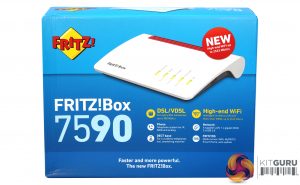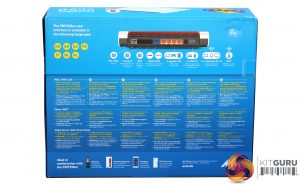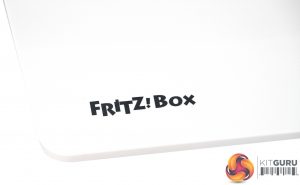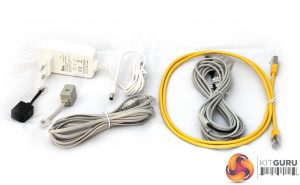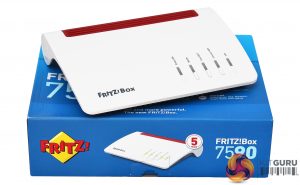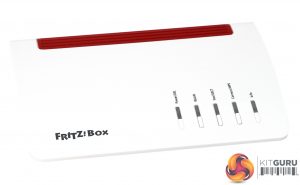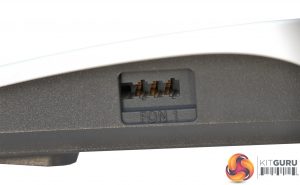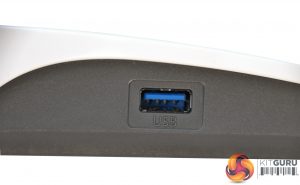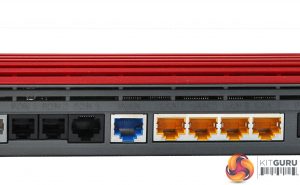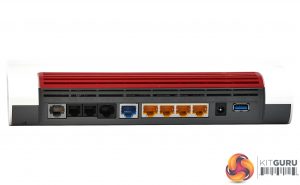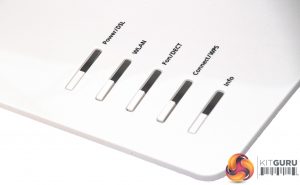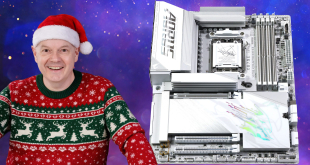The AVM box is decidedly colourful, which is somewhat at odds with the powerful business-oriented features of the product contained within.
Quite a few cables are included in the box. Aside from the power supply and obligatory CAT5 Ethernet cable, there's a 4m DSL-telephone connecting cable, and AVM also sent us a Y-cable going from DSL to BT and US-style RJ-11 plugs, as well as one with two RJ45s at the other end. There are also two adapters routing different pins on RJ11 to RJ45, one for DSL and one for analog telephony.
The 7590 has a different look to most wireless routers, with a mostly glossy white casing, apart from the red grille at the rear to let heat out from the circuitry beneath.
On one side is a USB 3.0 port for connecting printers and storage, and on the other a mysterious phone port. This is actually a German TAE telephone connection, which is also used in Liechtenstein and Luxembourg. So if you happen to have a Germanic phone with this plug, you can connect it here, or use an adapter to transform this into another analog phone connection type.
The rear of the 7590 is a veritable port parade. Starting from the left, there's a DSL port with support for VDSL 35b super vectoring, which theoretically enables DSL lines at up to 350Mbits/sec by using 35MHz of the spectrum rather than the usual 17MHz. This is an alternative technology to G.fast, with a lower maximum speed but better performance at greater cable lengths. Unfortunately, BT's Openreach appears to be putting its development behind G.fast, which some AVM routers support (such as the 7582) but sadly not this one.
Next to the DSL port is the trio of telephony connections. Two RJ11s can be used for connecting analog phones and faxes directly. The next port is RJ45 format, for digital ISDN telephones and devices. Next along is another RJ45 for regular Gigabit Ethernet-based WAN connections. This can be used as a fifth LAN port if you're using the DSL port for your broadband.
The yellow RJ45s provide the usual four-port Gigabit Ethernet switch connections for wired devices. Finally, after the power connection, there's another USB 3.0 port for connecting printers and storage. This also supports a USB mobile broadband dongle.
The front right-hand corner is home to five LEDs, the middle three of which are accompanied by buttons. The WLAN button is for turning the WiFi off and on. The Fon/DECT button pages for cordless phones (in case you've lost them behind the sofa). The Connect/WPS button has dual functions, registering WiFi devices via WPS but also DECT cordless handsets. As we mentioned earlier, the 7590 has a built-in DECT hub. This supports up to six DECT handsets, but also up to 10 FRITZ!DECT 200/210 power outlet switches and up to 12 FRITZ!DECT 300/Comet radiator controls. So this device can also act as the hub of a smart home system.
Just the range of ports and their many capabilities provides a hint of how much functionality the AVM FRITZ!Box 7590 incorporates. But the 278-page manual you can download from AVM's website makes this considerably more obvious. So next, we turn to the Web interface, where configuration of these functions can be found.
 KitGuru KitGuru.net – Tech News | Hardware News | Hardware Reviews | IOS | Mobile | Gaming | Graphics Cards
KitGuru KitGuru.net – Tech News | Hardware News | Hardware Reviews | IOS | Mobile | Gaming | Graphics Cards


